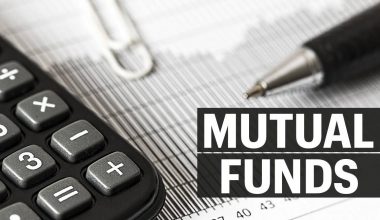The market value of every security that the mutual fund scheme owns is known as Net Asset Value (NAV). The NAV, or net asset value, of a mutual fund scheme, would show how well it did. The Net Asset Value of a mutual fund is determined by dividing the value of its underlying securities on a given date by the number of units outstanding in that fund. Read further to know more about; Nav in mutual Funds, how is Nav calculated and what is Nav for business.
The net asset value of an investment fund is found by dividing the number of outstanding shares by the fund’s assets minus its debts. NAV is the price at which shares of funds that are registered with the U.S. Securities and Exchange Commission (SEC) are exchanged and is most frequently used in relation to mutual funds or exchange-traded funds (ETFs).
Companies’ net assets, net worth, or capital are the difference between their assets and liabilities. The fund’s NAV is calculated by dividing the difference between assets and liabilities by investors’ shareholdings.
Because it’s a “per-share” value, the fund’s NAV is easier to price and trade.
The book value of a company and its net asset value (NAV) are frequently similar or comparable. Companies with strong growth potential get more value higher than their NAV may indicate. The most frequent technique to determine an investment’s valuation is to compare its NAV to its market cap.
Mutual funds buy stocks, bonds, and money market products with money from many investors. Each investor gets a certain number of shares based on how much money they put in. NAV determines the price of each share.
Unlike stocks, mutual funds are priced at the end of the day depending on the activity of their securities.
At the end of the trading day, the managers of a mutual fund add up the closing prices of all the securities in its portfolio, add the value of any extra assets, take into account any liabilities, and use the number of outstanding shares to figure out NAV.
Open-end funds can issue unlimited shares and price themselves daily at their price. Open-end funds make up the majority of mutual funds, including those in 401k programs.
Closed-end funds can trade at a price different than their net asset value on a stock exchange like stocks. ETFs trade like stocks, and the market value and actual NAV may not match.
Active ETF traders who can recognize profitable trading opportunities can benefit from this. ETFs calculate their NAV daily at market close for reporting purposes, just like mutual funds do, but they also calculate and distribute their intra-day NAV several times per minute in real time. Investors in mutual funds often use the difference in NAV between two dates to try to figure out how well the fund is doing.
Investors can use the difference between the NAVs on January 1 and December 31 as a barometer for the success of the fund by comparing the two numbers. NAV fluctuations aren’t the most accurate indicator of mutual fund performance between two dates.
Most of the time, mutual funds give their owners all of their earnings, including dividends and interest. They must also distribute any cumulative capital gains to the owners via mutual funds.
The NAV decreases as these two elements, income and profits, distribute routinely.
So, even if a mutual fund investor gets income and returns, they do not take those earnings into account when comparing the absolute NAV values between two dates.
The annual total return, which is the actual rate of return of an investment or a pool of investments over a specific evaluation period, is a trustworthy indicator of mutual fund performance. The compound annual growth rate (CAGR), which shows the mean annual growth rate of an investment over a given period longer than one year, is another metric that investors and analysts consider.
Net asset value (NAV) is the monetary worth of a company’s assets. You calculate the net worth of a company or investment fund by taking its assets and subtracting its liabilities in the world of finance.
The market value per share of a mutual fund is represented by its net asset value (NAV). The bid price and the redemption price are the askings and asking prices, respectively, at which investors purchase and redeem shares of a mutual fund from the fund’s issuing business.
A fund’s NAV is calculated by dividing its cash and securities portfolio, fewer liabilities, by its outstanding shares.
Based on the closing market values of the assets in the portfolio, a NAV calculation is performed once at the conclusion of each trading day. The calculation of a mutual fund’s NAV follows a simple formula:
You need to calculate NAV as (assets – liabilities) / the total number of outstanding shares.
Consider a mutual fund with $60 million in total assets and $5 million in securities and $ 10 million in cash. Liabilities for the fund total $20 million. The fund would then be worth $40 million in total.
In order to determine the cost of a single unit of a fund’s stock, investors need to know the overall worth of the fund. NAV is usually given in terms of the price per unit, which is found by dividing the total value of a fund by the total number of outstanding units. As a result, they update the NAVPS and the price of a mutual fund at roughly the same time.
When trading mutual fund shares, which are issued by firms and traded on stock exchanges, the NAV pricing structure is very different from that of common stocks or equities.
Initial public offers (IPOs) and secondary offerings (if any) of a company’s stock are methods through which its stock can be made available to the general public for trading on markets like the New York Stock Exchange (NYSE). The market, or the supply and demand for shares, determines stock prices. Market demand exclusively values or prices stocks.
The amount invested in a mutual fund, it’s operating expenses, and the number of outstanding shares, on the other hand, all contribute to the fund’s value. The NAV does not provide a performance indicator for the fund; the NYSE does. The NAV of a mutual fund is mostly irrelevant when evaluating a fund’s performance because mutual funds distribute almost all of their income and realized capital gains to fund shareholders. Total return, which includes dividends and stock performance, is the best approach to analyze a mutual fund.
Thinking of how NAV is calculated? Here is the formula:
NAV = (Assets – Liabilities) / Total number of outstanding shares
Using the day’s closing prices for each asset, assume that a mutual fund has $200 million worth of total investments across a variety of securities.
A total of $6 million in receivables and $10 million in cash and cash equivalents are also on hand. The day’s total earnings are $80,000. The fund is liable for $10 million in long-term obligations and $15 million in short-term obligations.
The total day’s expenses are $20,000 thus far. There are 10 million active shares of the fund. You can use the following equation to determine the NAV:
NAV = [($200,000,000 + $6,000,000 + $10,000,000 + $80,000) – ($10,000,000 + $15,000,000 + $200,000)] / 10,000,000 = ($216080000 – $25200000) / 10,000,000 = $19.088
They sell each share of the mutual fund that day for $19.088.
An investment company’s net asset value, or “NAV,” is the sum of its assets less the sum of its liabilities. The difference between a business or enterprise’s assets and debts is called its capital, net worth, or net assets.
The difference between a mutual fund’s trading price and its NAV changes based on supply and demand. The market price will often be higher than the NAV if there is a high demand for the fund and a low supply. The market price will typically be less than the NAV if there is a large supply and little demand.
Investors can purchase or sell units of the fund at a price known as the NAV (on a per-share basis). It rises as the value of the securities in the fund does. The net asset value of a fund falls when the value of its holdings’ value falls.
This is why investors refrain from mutual funds with a high NAV. Investors may be led to believe that a fund with a high NAV will yield a poor rate of return because of its high price. As an alternative, you favor mutual funds with a low NAV.
It doesn’t, however, affect how the fund will operate going forward. Some investors share this view and think a fund with a lower it is preferable. There is general agreement that it has more room for expansion because it is smaller.
The NAV is negative when a fund’s performance is declining. The value of your investment would not change despite a change in it.
It should be 50 per unit. Higher NAVs are an indicator of the schemes’ prior success or longevity. This is owing to the fact that strong performance would have improved the fund’s net assets. Financial gurus think that investors don’t care whether it is greater or lower.
They often give the net asset value per share (NAVPS) of a fund along with its price quote by a broker or online financial site. Since NAVPS is determined once per day, and the price of the assets owned by a fund may change throughout the day, this value is frequently close to, but significantly different from, the fund’s real market price.
What Causes a Change in the Net Asset Value of a Mutual Fund?
A fund’s assets will vary in value as a result of changes to the holdings in its portfolio, which will modify it. Additionally, if the fund’s liabilities alter, they may also fluctuate.
A broker or online financial portal will report a fund’s NAVPS and price quote. Since NAVPS is determined just once every day, and the price of the assets owned by a fund may change throughout the day, this number is slightly different from the fund’s actual market price.
Even though they calculate and report NAV as of a certain business day, all buy and sell orders for mutual funds and process it base on the NAV of the trade date at the cutoff time. Buy and sell orders submitted before 1:30 p.m. will be executed at the NAV on that date if regulators demand a 1:30 p.m. cutoff time. If you place an order after the cutoff time, you will fulfill it by using the previous business day’s NAV.
Besides the fund’s valuable assets, a high NAV tells little. It’s crucial to compare items relative to one another, such as the NAV of various growth funds. Comparing a fund’s NAV to its market price is also crucial. It may indicate a potential buying opportunity if the NAV is significantly greater than the current market price.
Investors look at a company’s book value to figure out how much it’s really worth. You get this number by subtracting its liabilities from its assets on its balance sheet. This figure is comparable to a fund’s net asset value, but a fund’s assets are company shares (in many instances).
Final Thoughts
You will find the net asset value of an investment fund by dividing the number of outstanding shares by the net value of the fund’s assets minus its liabilities. The price of each share is based on the NAV, and funds may be opened or closed.
Related Articles
- Net Asset Value: Calculations, Formula, Calculator, & Quick Guide
- BUSINESS CREDIT SCORE: How to Check Your Business Credit Score
- What Is A Closed End Fund? How It Differs From Open End Fund
- Types of Mutual Funds: 31+ Different Types (+ Quick Guide)
- 5K SMALL BUSINESS GRANT: Best Easy 2022 Application Guide






